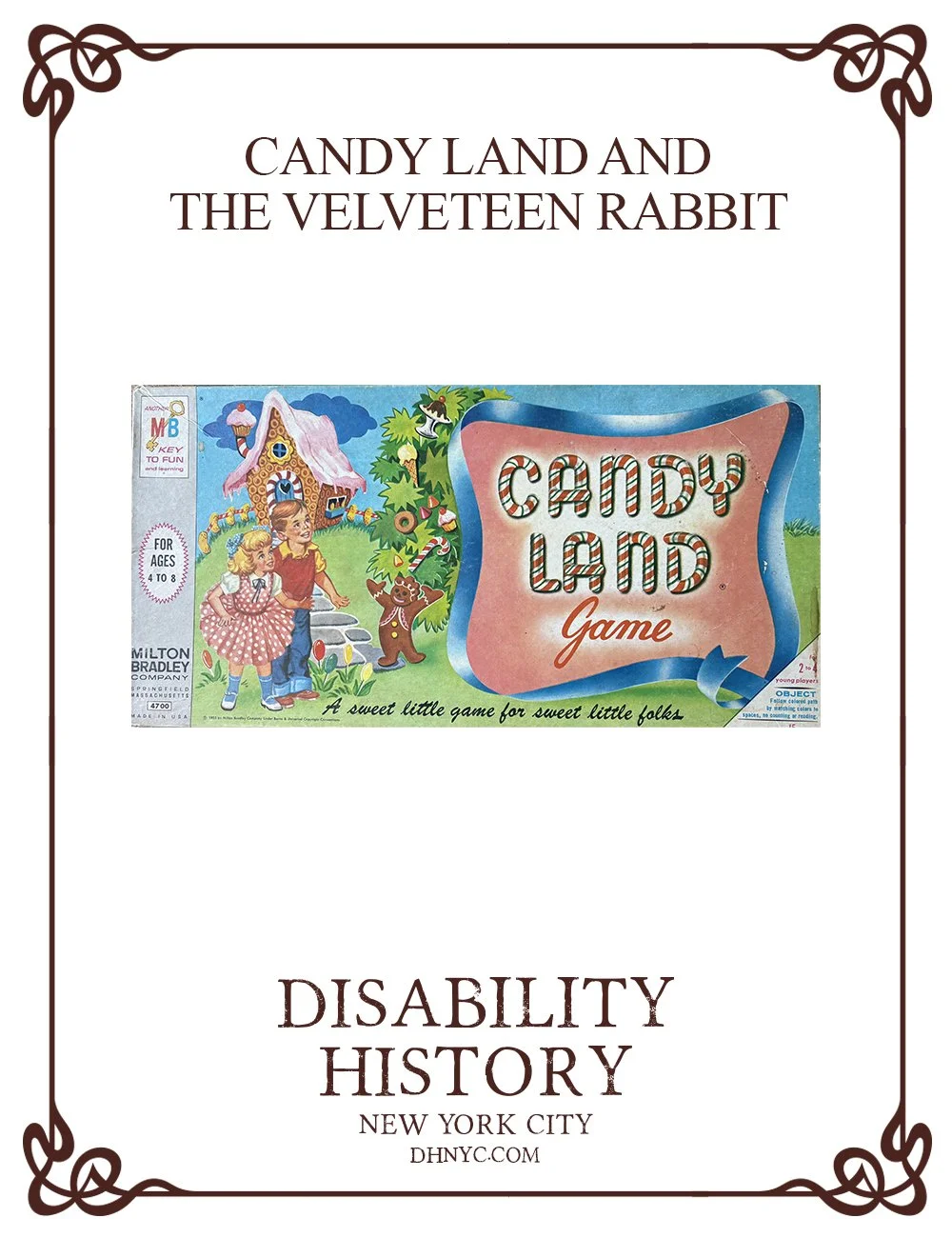Candy Land and The Velveteen Rabbit
To paraphrase the scholar Douglas C. Boynton, “disability is everywhere, once you go looking for it.” Here are two examples of Boynton’s point—a board game and a book with less than obvious but potent disability connections.
In Image No. 1 – a vintage version of the board game “Candy Land,” circa 1955-1962
First, is there anyone who hasn’t played “Candy Land?” It’s practically a universal preschoolers’ experience. The game is a chipper little trip through a board that features sweet spots like “Lollypop Woods” and the “Gumdrop Mountains.” Keyed to kids who haven’t learned to read, the players advance through color-coded steps along a convoluted path, until they finally reach the end—“home sweet home,” as the game calls it.
The game has gone through dozens of different editions, but in the early versions the game pieces were noticeably anonymous, nothing more than tinted, vaguely humanoid shapes. Likewise, early versions of the board had few if any characters. I don’t think the absence of people is an accident.
“Candy Land” was developed in 1948 by Eleanor Abbott, a school teacher, while she was a patient in a polio ward. She created the game to ease her own boredom, and to do the same for the children in the ward with her.
In our time, hospitals take considerable pains to provide some warmth and cheer in children’s areas. Cartoon characters adorn walls that are painted in upbeat tones. Music and TV fills the ear and eye. None of that existed in Abbott’s day. There was no radio, no toys, no books, no posters. A typical polio ward then meant 20 or 25 patients, often very young children, stuck in their beds and staring up at the ceiling with literally nothing to do, in a big barnlike room most likely painted a ghastly hospital green. Not infrequently, polio kids remained in these institutions for years.
Against this dreary backdrop, Abbott’s game brought explosions of color and tantalizing images of sweets. Why no characters? Because while candy was something that a medical institution might provide as a special treat, hospital policy in those typically restricted visitors to once or twice a week. Even worse, some children were abandoned by their families and never had any company at all. I think that the game omitted characters to help distract the little patients from their loneliness instead of rubbing it in. The board’s convoluted path symbolized what the kids were going through, while “home sweet home” was what they were hoping for.
None of this is obvious from the face of the game, of course, and “Candy Land” proved a big hit for the Milton Bradley Company, which produced a mass market edition beginning in 1949. The game has never been out of production, but its disability roots have never been widely known.
In Image No. 2 – a reprint of original edition of “The Velveteen Rabbit.”
Another children’s perennial with a covert disability angle is “The Velveteen Rabbit.” It is the sweet but poignant tale of a toy, a stuffed rabbit, and its desire to become “real” through the love of its owner, a little boy. After several years together, the boy barely survives a bout of scarlet fever, and all of his possessions are burned to prevent contagion—including the stuffed rabbit. Still, somehow it manages to be reincarnated as a real rabbit, which the boy recognizes as resembling his beloved toy.
The hidden disability angle is hinted at by the book’s publication date – 1921, just a few years after the Great Polio Epidemic of 1916.
The 1916 polio epidemic was by several orders of magnitude the worst ever recorded. There were 27,000 cases of paralysis spread across twenty-six states, and the highest fatality rates ever recorded for the disease. The Great Polio Epidemic produced widespread panic, quarantines and travel bans, and catapulted polio from a relatively obscure condition into a byword for terror.
Since no one knew what caused polio or how to prevent it, burning the possessions of an infected child became a fairly common response. This, of course, compounded the losses suffered by such children, and in taking the perspective of one of those lost possessions, the book furnished a vehicle for releasing and coping with grief.
Why isn’t polio mentioned anywhere in the book? I think it was just too scary a subject, back in 1921. In the same way that few works emerged to tell the tale of the Influenza Pandemic of 1918 (or of Covid-19, at least so far). Scarlet fever was a less inflammatory choice of illness.
“The Velveteen Rabbit” is the story of the enduring and redemptive power of love, and the need for resilience. More than a century later it has lost none of its punch. It’s a quick read, but be prepared for an (age-appropriate!) emotional wallop.
So there you have it – two anything but obvious disability artifacts with perennial and widespread appeal. Share them with a youngster in your life!
Note: a version of this entry appeared in Able News, ablenews.com
by Warren Shaw


